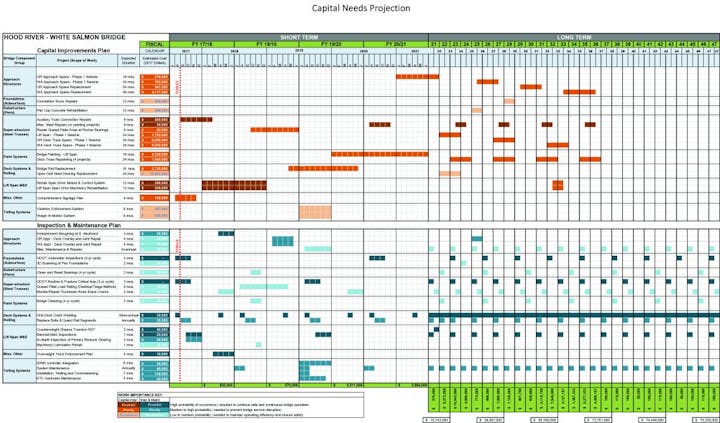Bridge Studies & Reports
As part of the Port’s management and maintenance of the Hood River Interstate Bridge, the Port will oftentimes contract with engineering firms and consultants to conduct studies on various aspects of the bridge structure. As the Port works toward the eventual replacement of the bridge, more studies will be needed. These and other reports will be available to the public for download on this page.
As requested by the Port of Hood River (Port), HNTB Corporation (HNTB) conducted a brief review of the more significant structural issues and opportunities related to adding a safe and viable pedestrian and bicycle crossing separated from vehicular traffic onto the existing Hood River-White Salmon Bridge (bridge).
Case Study PDFIn June 2009, the Port of Hood River and the Hood River Valley Residents Committee (HRVRC) contracted with Alta Planning + Design to investigate and recommend a course of action to enable bicyclists and pedestrians to cross the Hood River Bridge.
2009 Final Report PDFSouthwest Washington Regional Transportation Council (RTC) along with the Oregon and Washington Departments of Transportation (ODOT & WSDOT), the Port of Hood River and the Port of Klickitat, and the local cities and counties have been working in partnership to find a long-term solution to the Columbia River crossing between Hood River in Oregon and White Salmon and Bingen in Washington.
The SR-35 Columbia River Crossing Study was conducted in response to local business and resident concerns about the safety and viability of the existing Hood River Bridge.
The project began in 1999, with the design of a feasibility study. In 2000, the feasibility study began by identifying project issues, purpose and need statement, and a range of crossing corridors and facility alternatives. This phase (Tier I) determined and initiated the environmental review process, and narrowed the corridors and facility alternatives to those that are most promising and practical. In 2001, the next phase (Tier II) began resulting in the selection of crossing corridors, refinement of the most promising long-term alternatives, and identification of short-term improvement options. This phase also undertook a financial feasibility study to determine if there are sufficient financial resources available to fund a long-term improvement project. In 2002, the final phase (Tier III) of the feasibility study was initiated. This phase was completed in 2004, resulting in the selection of a preferred alternative through a Draft Environmental Impact Statement. In 2010, a Bridge Type, Size, and Location Study (TS&L) began. Bridge concepts were analyzed to identify the concept that best meets the needs of the region. This phase resulted in a recommended bridge type.
With a Draft Environmental Impact Statement and preliminary engineering completed, the next step in the process is the development of a Final Environmental Impact Statement. Although funding is unsecured at this time, a scope of services outline has been developed that lists the activities and areas of further study needed to complete a Final Environmental Impact Statement. Final engineering and right-of-way purchase would follow. Given current local, state, and federal transportation funding limitations, construction of the new SR-35 Columbia River Bridge is likely to be a long-term future project.
SW Washington Regional Transportation Council SR-35 Columbia River Crossing Study
To address Port concerns that excessive truck weights cause accelerated degradation of the bridge, CRPE performed an assessment to identify possible strategies to reduce long-term degradation. In particular, whether there are there toll strategies and/or enforcement measures that can be taken to reduce the number of overweight trucks using the Bridge.
Heavy Haul Trucking Assessment
